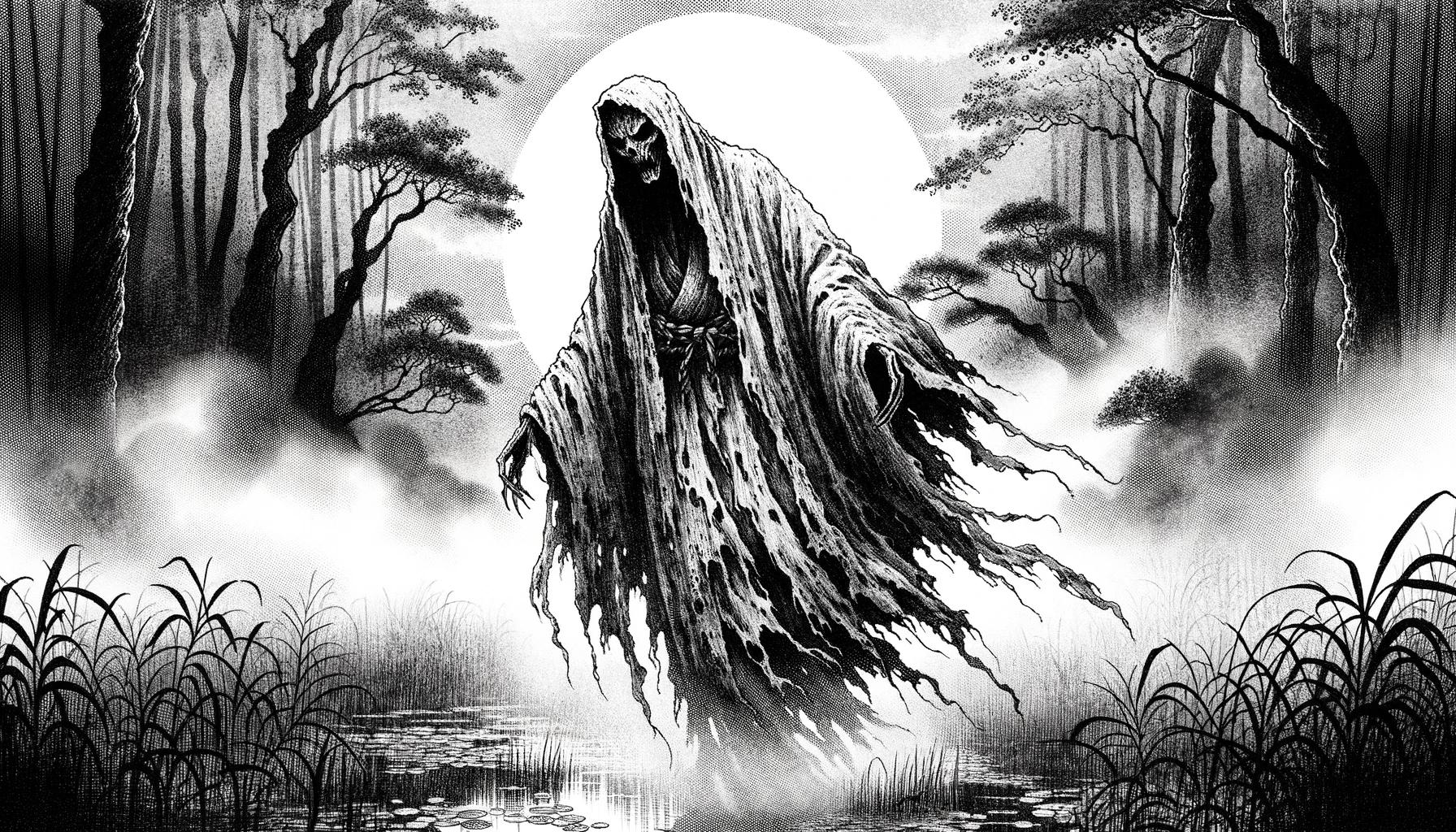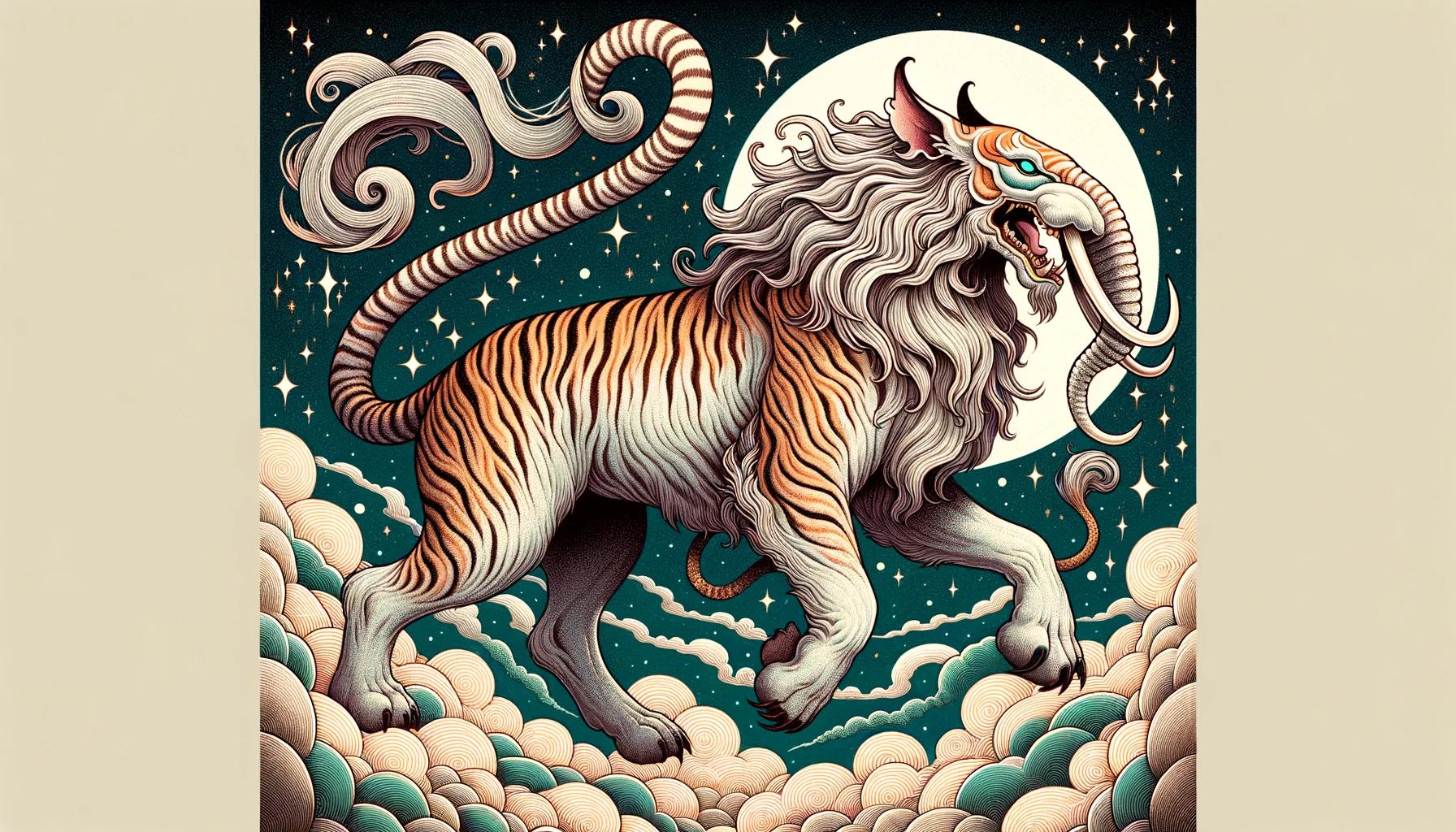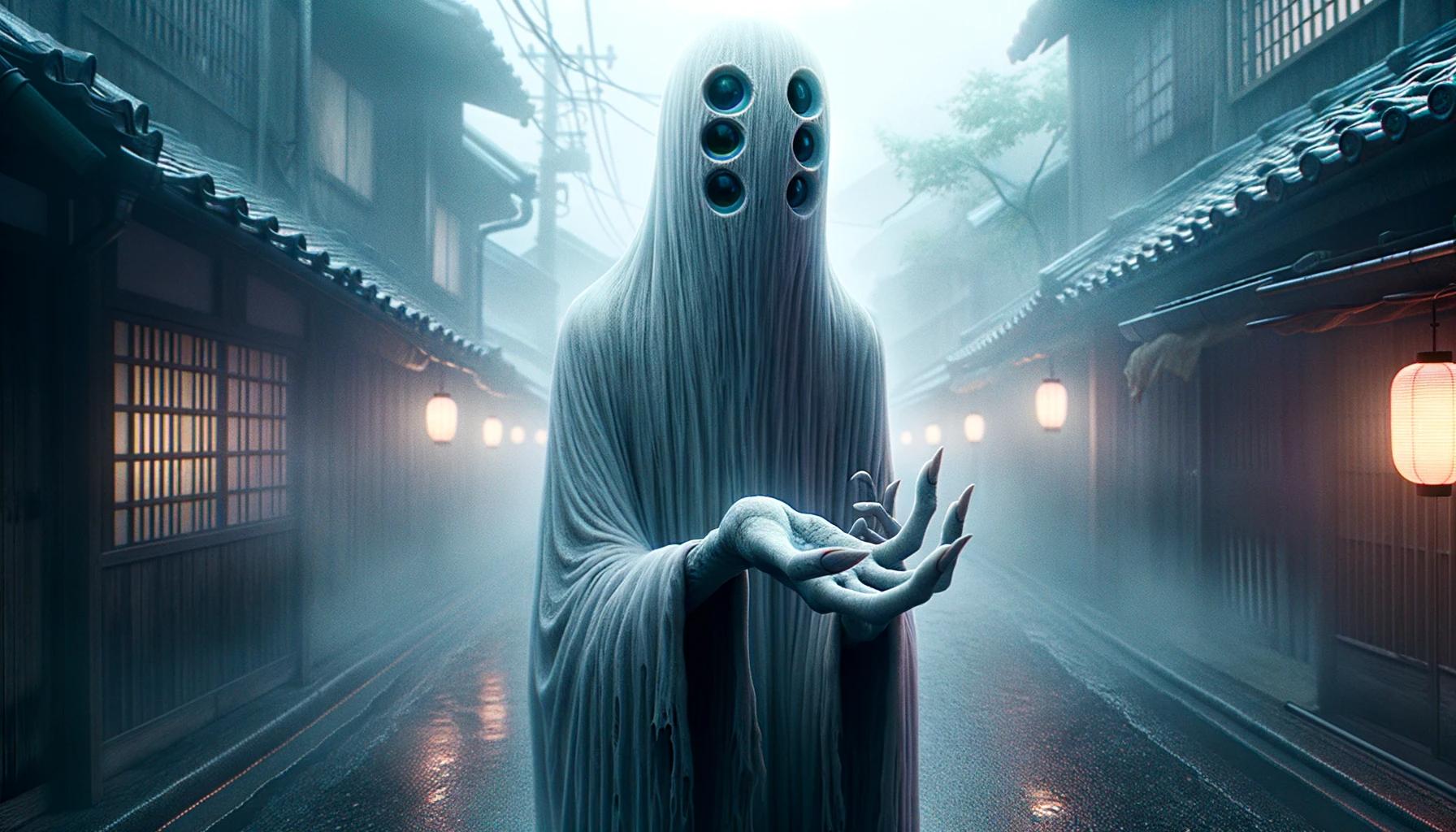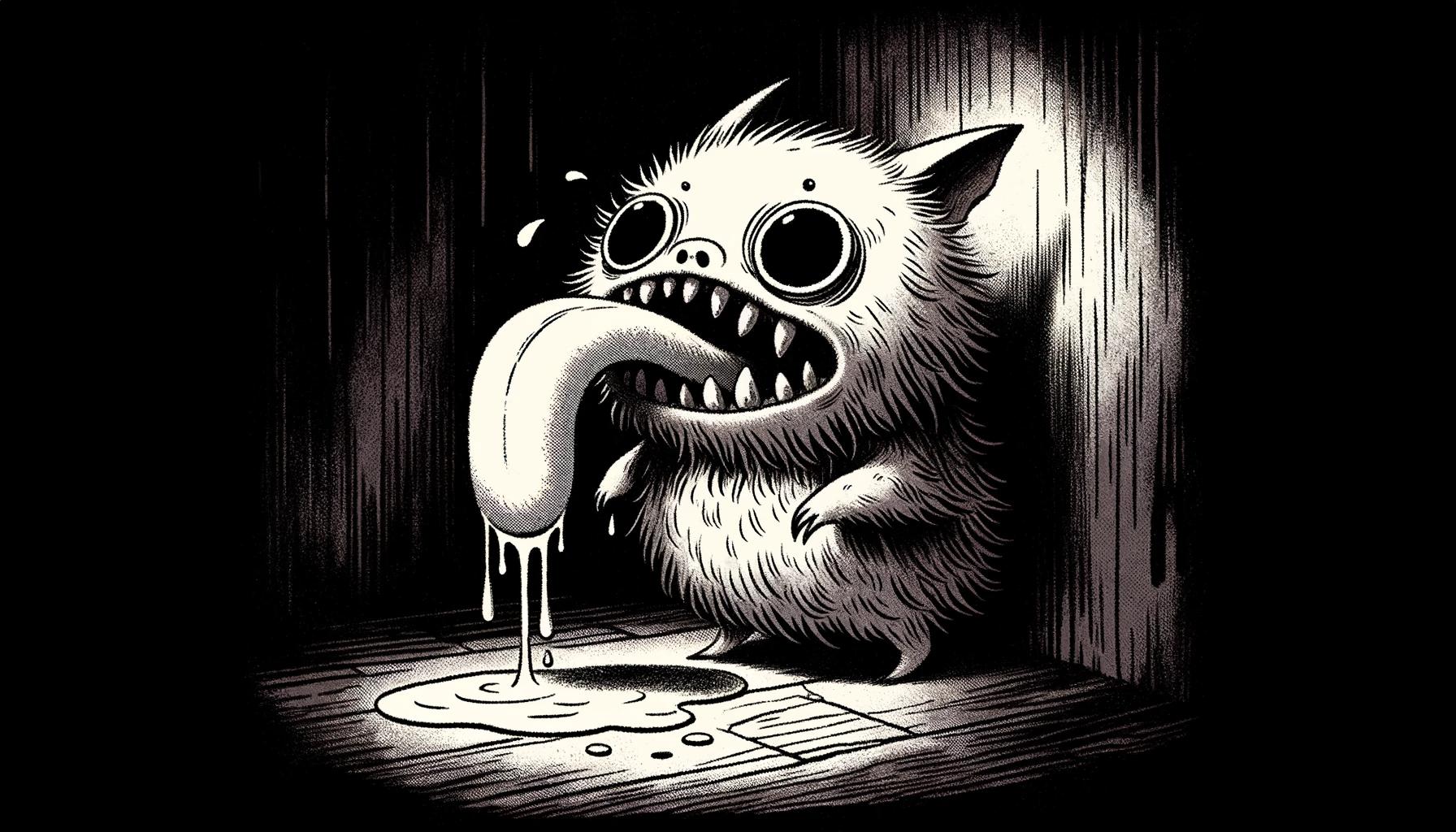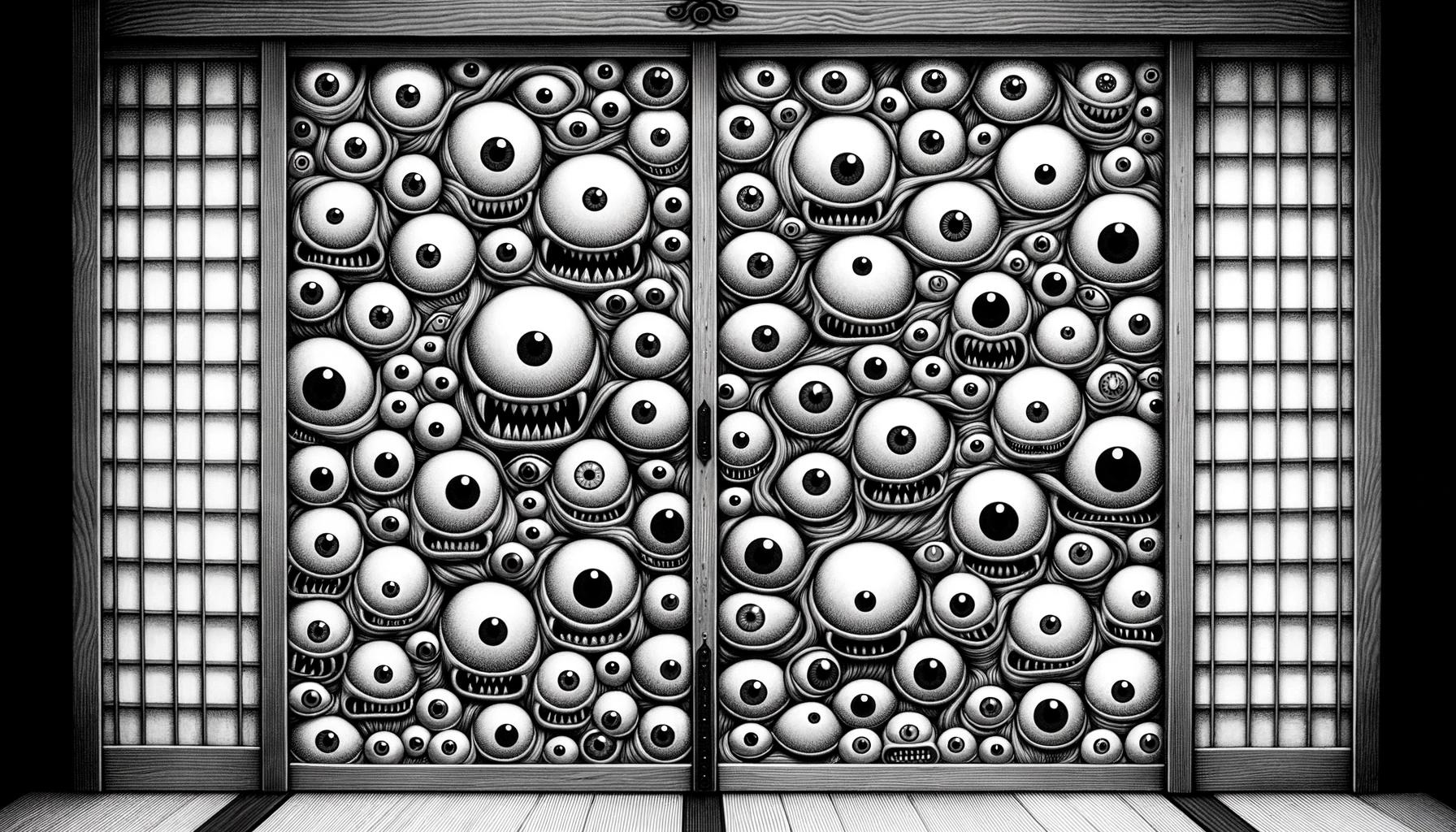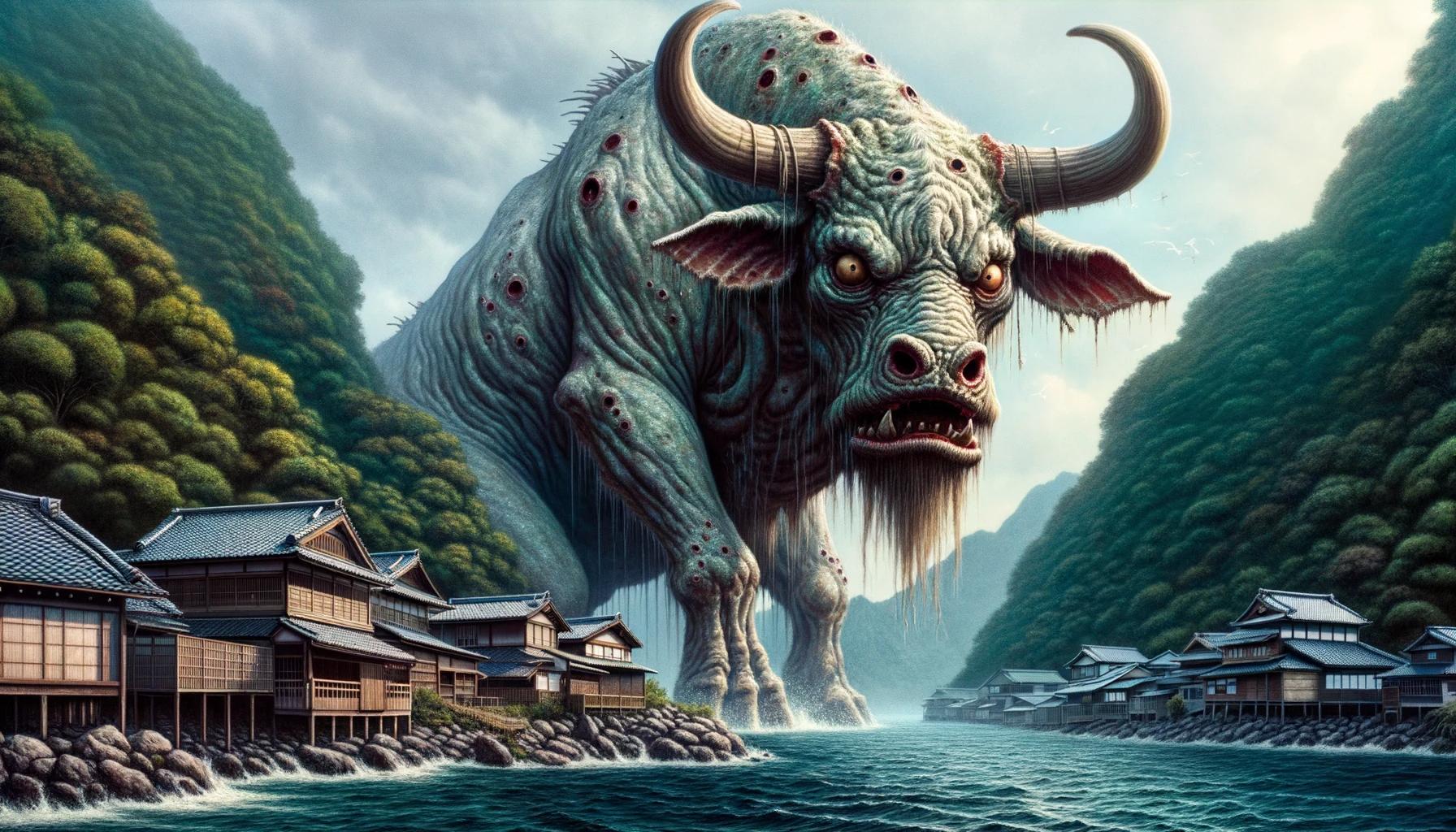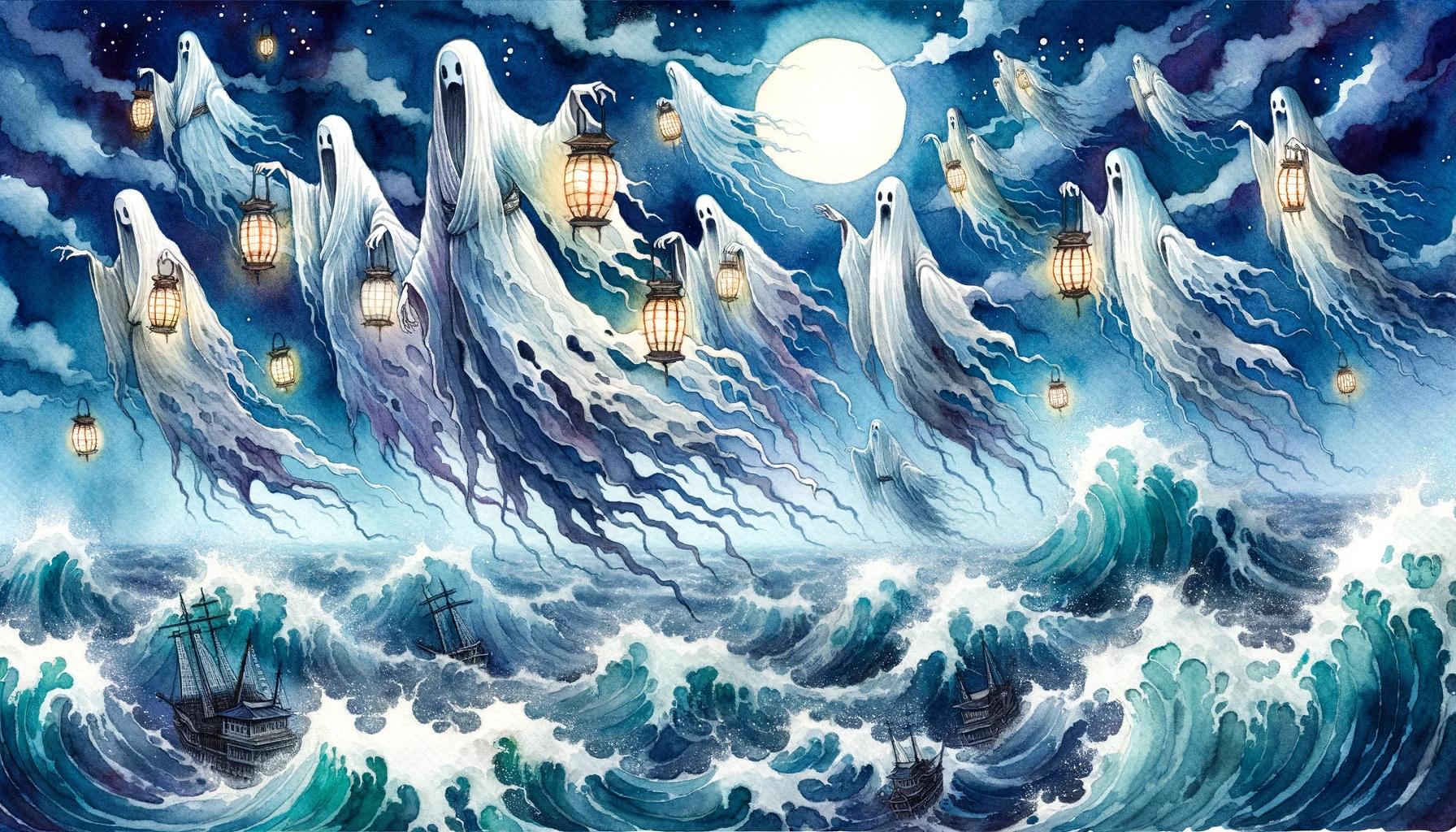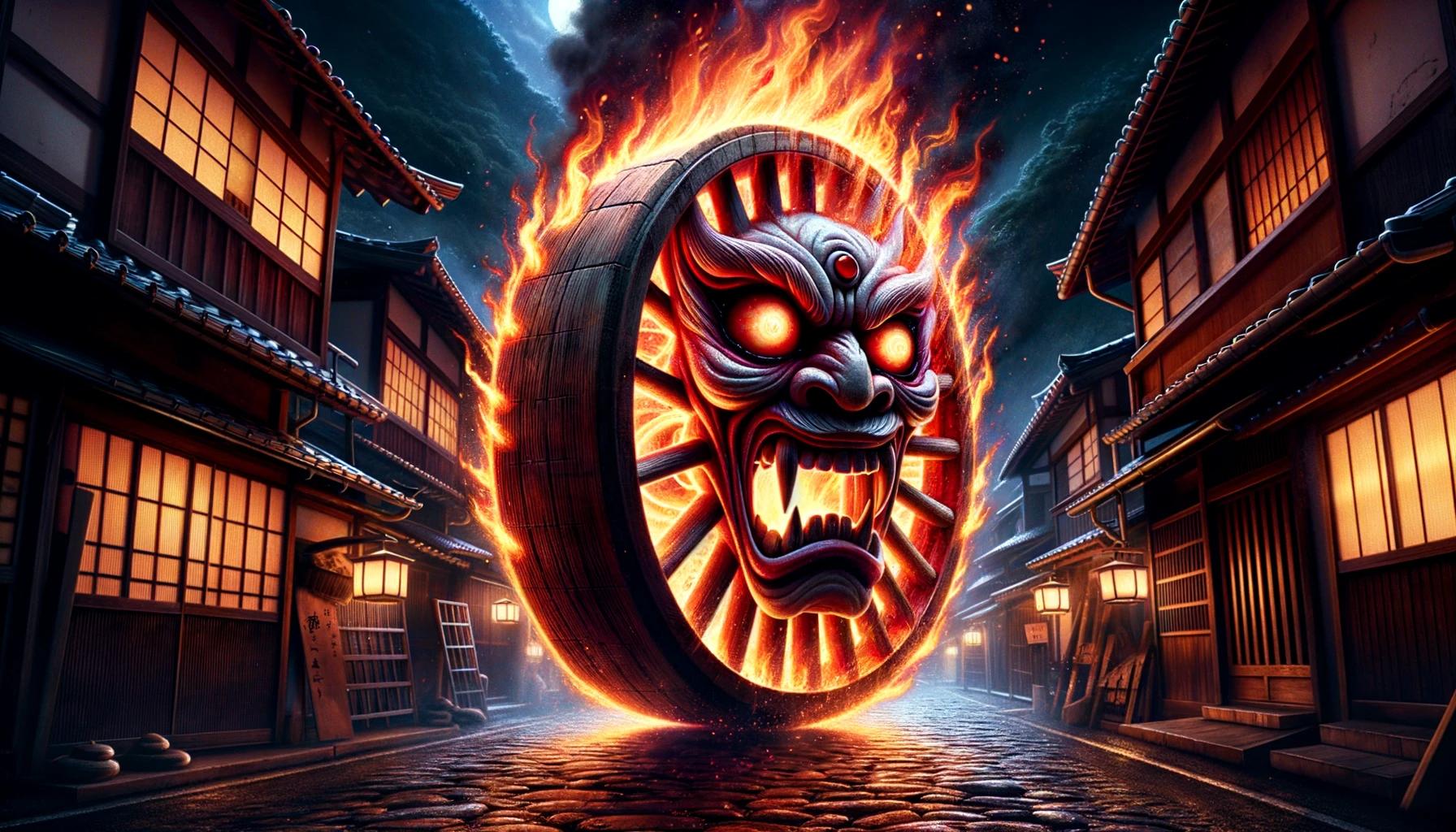What is an Onryo Yokai: Exploring the Vengeful Spirits of Japan
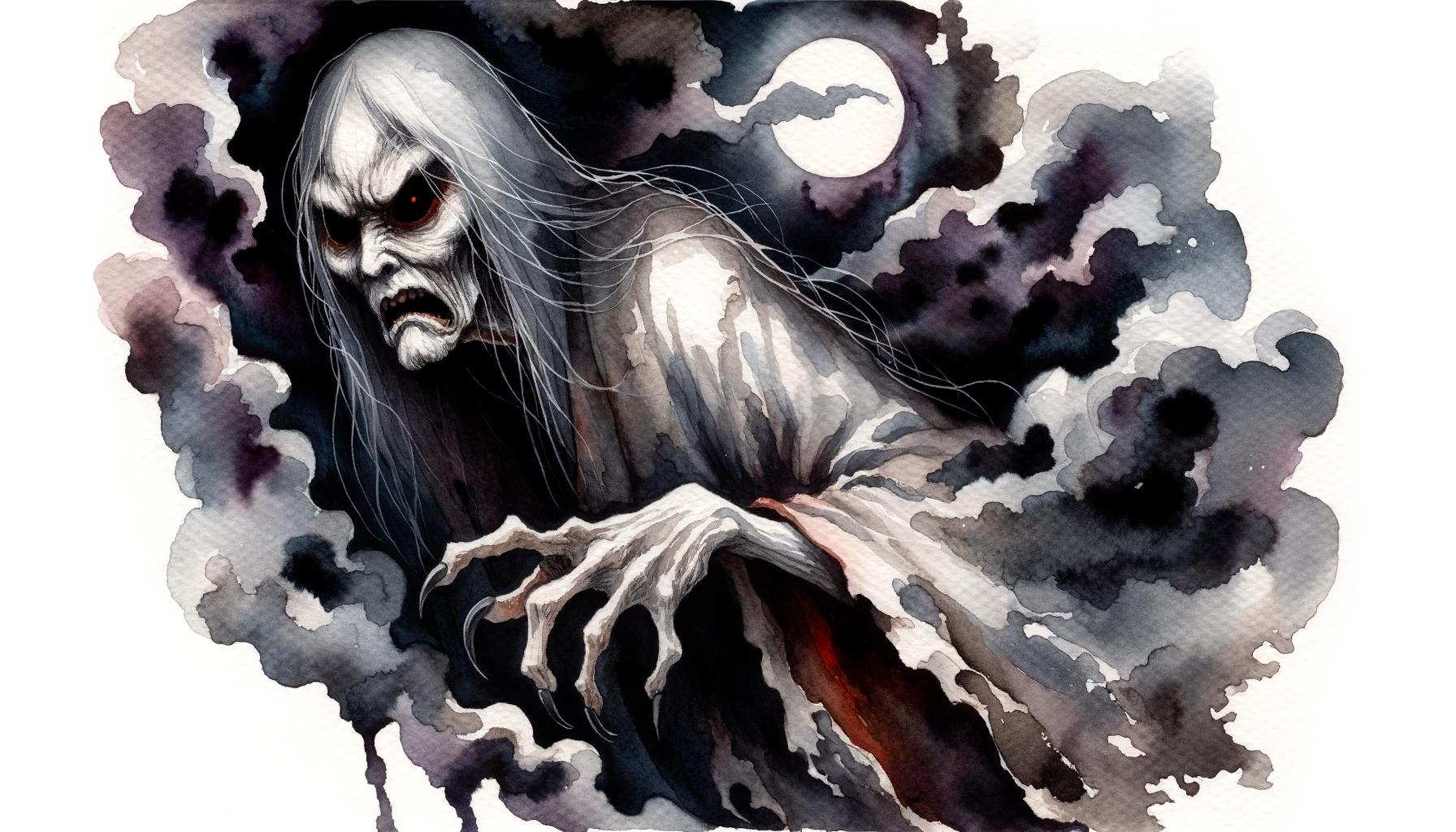
Onryō in Japanese Mythology
In Japanese mythology, onryō are vengeful spirits that hold a prominent role. They are spirits of individuals who have died under cruel, unnatural, or unjust circumstances, seeking retribution from beyond the grave.
Often depicted as women, these onryō haunt the living world, driven by intense anger and a desire for revenge upon their oppressors. These malevolent spirits are known for physical manifestations, making their presence felt rather than just appearing as ethereal entities.
The onryō are just one type of vengeful spirits in Japanese folklore, alongside other formidable entities like the funayūrei (spirit of the drowned) and the kuchisake-onna (vengeful spirit with a slit mouth).
These powerful beings are deeply rooted in Japanese culture, influencing various forms of art, literature, and entertainment.
Beliefs surrounding onryō highlight the importance of appeasement through religious and cultural practices. Rituals and exorcisms are performed to pacify their wrathful spirits.
Stories and legends of onryō serve as cautionary tales and emphasize the consequences of harboring grudges or perpetrating acts of cruelty.
The presence of onryō in Japanese mythology reflects the belief in the supernatural and serves as a reminder of the enduring power of vengeful spirits.
Their stories are intriguing and continue to captivate audiences, both in Japan and beyond, offering a unique glimpse into the rich tapestry of Japanese folklore.
The Vengeful Spirit of Onryō
The concept of the Onryō in Japanese mythology is that of a vengeful spirit seeking retribution for a perceived injustice in their past life. These spirits are primarily depicted as women who met tragic and cruel fates, leading them to return from the afterlife with a burning desire for vengeance.
Onryō are not your typical ghosts; they are often portrayed as physical entities rather than ethereal apparitions, making their presence all the more terrifying. Their wrath knows no bounds, and they will ceaselessly haunt and torment their murderers or tormentors until justice is served.
These malevolent spirits hold a prominent place in Japanese folklore, influencing various aspects of the culture and artistic expressions. They are a chilling reminder of the consequences of past wrongdoings and the lingering power of unresolved grievances.
From ancient tales to modern media adaptations, the vengeful spirit of the Onryō continues to captivate audiences both in Japan and beyond.
- Onryō are vengeful spirits seeking justice for past wrongs.
- They are often depicted as women who have suffered cruel and tragic fates.
- Onryō are not ethereal, but rather physical entities.
- They haunt and torment their murderers or tormentors relentlessly.
- The presence and influence of Onryō can be found in Japanese folklore and art.
- Their stories and depiction have remained relevant in modern media adaptations.
The Female Onryō: Exploring a Vengeful Woman
In the realm of Onryō yokai, the vengeful spirits of Japan, the female characters hold a significant role.
These vengeful women are an intriguing aspect of Japanese folklore, often depicted as tormented souls seeking justice or revenge for the harm they endured in their lives.
The Female Onryō are commonly portrayed as victims of tragic circumstances, having suffered from cruel treatment, abuse, or untimely deaths.
Their relentless pursuit of retribution against their tormentors sets them apart in the realm of Yokai mythology.
Exploring the stories of these vengeful women provides insights into the deeper cultural and societal issues present in Japanese folklore.
It unveils the enduring themes of injustice, female oppression, and the triumph of the oppressed seeking restitution.
These vengeful apparitions, often taking on physical forms rather than spectral, hold a captivating and fearsome allure.
Their presence in Japanese mythology and media exemplifies the enduring fascination with the supernatural and the human condition.
By delving into the realm of the Female Onryō, we can gain a better understanding of the complex narratives and themes woven into the tapestry of Japanese culture and folklore.
Onryō and Death in Japanese Culture
In Japanese culture, the concept of death plays a significant role in understanding the existence of onryō yokai. These vengeful spirits are born out of tragic and unjust deaths, seeking revenge against those who wronged them in life.
The belief in the afterlife and the existence of spirits is deeply rooted in Japanese culture, with death being seen as a profound transition rather than an end. The onryō, as embodiments of unresolved anger and resentment, represent the lingering emotional energy of the deceased.
Death rituals and funeral practices hold great importance in Japanese society, as they are believed to ensure a peaceful transition for the deceased into the afterlife. Failure to provide proper rituals and respect to the departed can provoke the creation of onryō yokai.
- The onryō phenomena often arise from deaths deemed cruel, unnatural, or unjust.
- These spirits relentlessly pursue their targets until justice is served or their tormentors meet their demise.
- Exorcisms and rituals are performed to pacify the onryō and release their vengeful energies.
- The rituals involve appeasing the spirit, ensuring a proper funeral, and providing closure to the deceased.
Understanding the cultural significance of death is crucial in comprehending the motivations and characteristics of onryō, shedding light on the enduring belief in the connection between life, death, and supernatural entities in Japanese folklore.
Onryō in Media: Movies, TV Shows, and Video Games
Onryō have become a captivating presence in popular media, with their eerie and vengeful nature inspiring numerous movies, TV shows, and video games.
- Movies: Onryō have been depicted in various Japanese horror films, exploring their vengeful pursuits and terrifying manifestations.
Some notable examples include “Ju-on: The Grudge” and “Ringu”, which captivated audiences with their chilling portrayals of Onryō.
- TV Shows: Onryō have also found their way into television series, providing haunting storylines and captivating viewers with their relentless revenge.
Shows like “The Terror: Infamy” and “Supernatural” have incorporated Onryō characters and themes, showcasing their spectral presence within the narrative.
- Video Games: The world of gaming has embraced the Onryō concept, featuring these vengeful spirits as formidable enemies or main characters.
Games like “Fatal Frame” and “Onimusha” have showcased the chilling encounters with Onryō, adding a supernatural twist to the gameplay experience.
The inclusion of Onryō in movies, TV shows, and video games allows audiences to explore their chilling presence and immerse themselves in the eerie world of these vengeful spirits.
Onryō and Women in Japanese Folklore
In Japanese folklore, onryō are often associated with women who have suffered injustice and untimely deaths. These vengeful spirits are mainly portrayed as female entities seeking retribution for the cruelties inflicted upon them during their lives.
The tragic circumstances surrounding their deaths, whether it be through despair or violent mistreatment, fuels their relentless pursuit of revenge.
Women depicted as onryō are emblematic of the societal issues and gender inequalities prevalent in ancient Japan.
Their stories serve as a reminder of the hardships endured by women and the consequences of their mistreatment. By embodying the spirits of these wronged women, onryō illustrate the themes of oppression, despair, and the desire for justice.
In Japanese folklore, onryō are not merely malevolent entities, but complex characters with a deep emotional resonance. Their portrayal highlights the profound impact of societal norms and injustices on women’s lives, immortalizing their anguish and struggles through the vengeful specters they become.
Through folklore and storytelling, onryō have become an integral part of Japanese cultural identity, shedding light on the challenges and experiences faced by women throughout history. Their haunting presence serves as a reminder of the importance of empathy, understanding, and striving towards a more equitable society.
Onryō in Literature: Yotsuya Kaidan and Other Tales
Onryō, the vengeful spirits of Japanese folklore, have long served as captivating subjects in literature. One notable example is the classic tale of Yotsuya Kaidan, a renowned ghost story that has stood the test of time.
Set in feudal Japan, this chilling narrative follows the tragic fate of Oiwa, a young woman betrayed by her husband and driven to seek revenge beyond the grave.
Yotsuya Kaidan is just one of the many stories that explore the themes of betrayal, vengeance, and supernatural justice associated with onryō.
Throughout Japanese literature, onryō have been featured in various other haunting tales, showcasing their relentless pursuit of retribution and the consequences faced by those who wronged them.
- “The Ghost Tower” by Lafcadio Hearn sheds light on the wrathful spirits that inhabit a cursed tower.
- In Kyoka Izumi’s “Illusion of Blood,” a tragic love story intertwines with the dark powers of vengeful ghosts.
- Masahiro Shinoda’s “Double Suicide” explores the psychological impact of onryō on the living.
These literary works not only provide captivating narratives but also offer readers a deeper understanding of the complex folklore surrounding onryō.
Through the lens of literature, audiences can explore the cultural significance of these spirits and the enduring tales they inspire.
As we delve into the rich world of onryō in literature, we unearth a treasure trove of haunting stories that continue to captivate and chill readers to this day.
Onryō and the Living: Their Impact and Beliefs
The presence of onryō, vengeful spirits in Japanese folklore, has had a significant impact on the lives and beliefs of the living. These vengeful entities continue to shape the cultural landscape, leaving a lasting imprint on Japan’s spiritual practices and societal beliefs.
Belief in onryō has instilled a sense of caution and fear among the Japanese population. Tales of these malevolent spirits serve as cautionary tales, reminding people of the consequences of injustice and cruelty.
Their stories have shaped cultural norms and ethical standards, emphasizing the importance of treating others with respect and fairness.
Furthermore, the recognition of onryō has fueled religious and spiritual practices aimed at appeasing these vengeful spirits.
Rituals, exorcisms, and prayers are performed to pacify the wrath of onryō and seek protection from their malevolence. These practices serve as a means of maintaining harmony between the living and the spirit world, reinforcing the deep-rooted belief in the interconnectedness of life and the afterlife.
Onryō’s influence extends beyond traditional beliefs and practices into various forms of artistic expression. Their presence is depicted in literature, paintings, theater, and even modern-day media such as movies, TV shows, and video games.
This portrayal not only perpetuates the fear and fascination associated with onryō but also serves as a medium for cultural preservation and storytelling.
Onryō in Modern Culture: Influence and Interpretations
The presence and influence of Onryō yokai in modern culture cannot be understated. These vengeful spirits have found their way into various forms of media, including movies, TV shows, and video games.
Their haunting tales and eerie nature continue to captivate audiences worldwide.
- The portrayal of Onryō in movies showcases their terrifying power and relentless pursuit of vengeance. From classic Japanese horror films to contemporary Hollywood productions, these spirits strike fear in the hearts of viewers.
- TV shows often explore the complex motivations and backgrounds of Onryō characters.
They delve into the psychological depths of these vengeful beings, making for captivating storytelling.
- Video games provide interactive experiences where players can directly confront Onryō and navigate the supernatural world. From atmospheric horror games to action-packed adventures, Onryō serve as formidable adversaries.
These interpretations of Onryō in modern culture allow us to examine and understand the enduring fascination with these vengeful spirits.
They tap into our primal fears, challenging us to confront the consequences of our actions.
Onryō: A Study of Vengeful Ghosts
Onryō, the vengeful ghosts of Japanese folklore, have sparked a deep fascination among scholars and researchers. Their tales offer a captivating insight into the dark realms of vengeance and redemption. Through extensive study and analysis, experts have sought to understand the origins and motivations behind these malevolent spirits.
One key aspect of studying onryō involves examining their historical and cultural significance. By delving into ancient texts and oral traditions, researchers have uncovered a wealth of information about the rituals, beliefs, and societal impact associated with these vengeful entities.
Another crucial area of exploration is the portrayal of onryō in various forms of media, including literature, art, and films. The representation of these vengeful ghosts provides valuable insights into how they have permeated popular culture and influenced public perception.
Furthermore, psychologists have delved into the psychology of vengeance, attempting to understand the complex emotions and mindset that drive onryō to seek retribution. This psychological perspective offers a deeper exploration of human nature and the potential for extreme acts of revenge.
In unraveling the enigma of onryō, scholars combine historical, cultural, artistic, and psychological analyses to gain a comprehensive understanding of these haunting vengeful spirits. Through this interdisciplinary approach, we can deepen our appreciation for the enduring legacy and enduring fascination with onryō in Japanese culture and beyond.
Onryō and their Connection to Female Victims
Within the realm of onryō yokai, there is a notable connection to female victims, particularly those who have suffered unjust treatment during their lives. These vengeful spirits often embody the anguish and pain inflicted upon them, seeking retribution against those who wronged them.
Women who became onryō may have met tragic fates due to various circumstances such as abuse, torture, or despair. Their spirits wander the mortal realm, driven by an insatiable desire for vengeance, relentless until their tormentors face their deserved punishment.
This recurring theme highlights the inherent injustices faced by women in Japanese folklore and society. It serves as a reflection of the struggles and mistreatment endured by countless individuals throughout history.
The onryō’s manifestation in physical form rather than spectral adds to the intensity of their wrath, making them even more formidable.
Legends surrounding onryō and their connection to female victims continue to permeate cultural narratives.
Their stories remind us of the importance of addressing gender inequality and creating a more just and equitable society.
Onryō and Rituals to Pacify Their Wrath
Onryō, the vengeful spirits of Japan, hold immense power and can wreak havoc on the living. To pacify their wrath, various rituals have been developed over time. These rituals aim to appease the onryō and bring about calmness and resolution.
One common ritual involves exhuming the remains of those who died unjustly or were denied proper burial rites. Following the appropriate funeral rituals, the remains are reburied, often accompanied by salt and fire rituals to cleanse and purify the spirit.
This act is believed to provide solace and peace to the vengeful onryō.
Shinto priests also play a crucial role in performing rituals to pacify onryō. These rituals include prayers, chants, and offerings made to the spirits.
The priests invoke the help of benevolent deities and perform purification ceremonies to ward off the malevolent influences of the onryō.
Community participation is often encouraged in onryō rituals, as collective efforts are believed to have a stronger impact.
People come together to create protective charms, perform cleansing ceremonies, and offer prayers for the appeasement of the vengeful spirits.
It’s important to note that the effectiveness of these rituals lies not only in their religious and spiritual significance but also in their psychological effect on the living.
The rituals serve as a means of addressing guilt, fear, and trauma associated with the presence of onryō, providing a sense of closure and peace.
The rituals to pacify the wrath of onryō reflect the cultural and spiritual beliefs of Japan, providing a way for society to cope with these vengeful spirits and seek harmony between the living and the dead.
Onryō and the Media: Popularity and Representation
The vengeful spirits known as Onryō have captured the fascination of various forms of media, gaining popularity and representation in movies, TV shows, and video games. These dark and vengeful entities have become iconic characters that continue to captivate audiences worldwide.
In movies, Onryō have been featured in numerous Japanese horror films, often depicted as eerie apparitions seeking revenge. Their chilling presence and the suspense they create make for spine-tingling experiences that have thrilled audiences for decades.
International filmmakers have also drawn inspiration from Onryō, incorporating them into their own narratives and contributing to the global recognition of these vengeful spirits.
TV shows have embraced the supernatural allure of Onryō as well.
From chilling episodes of paranormal investigation series to supernatural dramas, Onryō have served as captivating plot devices, enticing viewers with their stories of vengeance and redemption. Their presence in popular TV shows has helped familiarize a wider audience with the concept of Onryō and Japanese folklore.
Video games have also embraced the Onryō theme, offering players interactive experiences with these vengeful spirits. Players can step into the haunted shoes of protagonists who encounter Onryō, navigating through spine-chilling environments and facing the wrath of these supernatural beings.
Their inclusion in video games has allowed players from around the world to immerse themselves in the dark and mysterious world of Onryō.
Overall, the popularity and representation of Onryō in various forms of media showcase their enduring appeal and the lasting impact of these vengeful spirits on popular culture across different countries and continents.
Onryō in Japanese Art and Literature
Japanese art and literature have long been influenced by the eerie presence of onryō. These vengeful spirits have become a captivating theme, inspiring various artistic expressions throughout history.
In painting and illustrations, onryō are often depicted as ethereal figures clad in white garments, their eyes glowing with an otherworldly intensity.
These haunting visual representations evoke a sense of dread and fascination, capturing the essence of these avenging specters.
Literature has also played a significant role in exploring the depths of onryō and their tales of revenge.
Classic works like “Yotsuya Kaidan” have popularized the onryō archetype, where tragic female figures seek justice from beyond the grave. These stories delve into the psychological implications of unresolved grievances and the relentless pursuit of retribution.
Onryō in Japanese art and literature serve as a reminder of cultural beliefs and societal values. They reflect themes of justice, the consequences of mistreatment, and the unyielding force of vengeance.
Through their portrayal in artworks and narratives, onryō continue to captivate audiences and provide insight into the complex nature of human emotions.
Onryō and the Supernatural: Understanding their Powers and Abilities
Onryō yokai possess a range of supernatural powers and abilities, making them formidable and feared entities in Japanese folklore.
These vengeful spirits are known for their relentless pursuit of justice and revenge, utilizing their supernatural attributes to further their cause.
- Enhanced Strength: Onryō are often depicted as possessing immense physical strength, capable of overpowering their adversaries with ease.
- Telekinesis: Many onryō have the ability to manipulate objects with their mind, often utilizing this power to torment their targets or defend themselves.
- Illusions and Shapeshifting: Onryō can manifest in various forms, sometimes appearing as innocent beings before revealing their true terrifying nature.
They can create illusions to deceive and confuse their victims.
- Unearthly Speed and Agility: Onryō possess supernatural speed and agility, enabling them to move swiftly and elusively, often appearing out of nowhere to strike fear into their targets.
- Curses and Malevolent Influence: Onryō have the ability to place curses on individuals or even entire communities, causing misfortune and suffering.
Their malevolent influence can spread like a plague, affecting those who cross their path.
The powers and abilities of onryō yokai vary, often depending on the circumstances of their death and the depth of their grudge.
This understanding helps shed light on why they are such a prominent and haunting presence in Japanese mythology and culture.
Onryō: A Historical and Cultural Perspective
The concept of Onryō holds significant historical and cultural relevance in Japanese society. Rooted in ancient beliefs and mythologies, Onryō are vengeful spirits that have captured the fascination of generations. Exploring the historical and cultural perspective of Onryō allows us to delve into the intricate tapestry of Japanese folklore and spirituality.
- The Origins: Tracing back to ancient Japanese mythology, Onryō have been present in folklore and literature, showcasing the deep-rooted belief in the afterlife and the existence of vengeful spirits.
- Role in Japanese Culture: Onryō’s presence has influenced various aspects of Japanese culture, including art, literature, and religious rituals.
The fear and respect for these spirits have shaped cultural practices, beliefs, and superstitions.
- Symbolism and Representation: Onryō embody deeply ingrained emotions of anger, sorrow, and injustice. They provide a lens through which societal issues, discrimination, and historical injustices can be examined.
- Influence on Pop Culture: Onryō’s captivating nature has made its way into modern media, with movies, TV shows, and video games showcasing these vengeful spirits, further perpetuating their cultural significance.
Exploring the historical and cultural perspective of Onryō allows us to better understand the rich tapestry of Japanese folklore, spirituality, and the enduring fascination with vengeful spirits.
This perspective provides valuable insights into the intricate connection between myth, culture, and the human experience.
Onryō and Shinto Beliefs: Spirituality and Worship
Shintoism, the indigenous religion of Japan, plays a significant role in understanding onryō yokai and their vengeful nature. Within Shinto beliefs, spirits, known as kami, permeate all aspects of existence, including natural phenomena, objects, and even deceased ancestors.
Shinto emphasizes harmony with nature and reverence for ancestral spirits.
In regards to onryō, Shinto beliefs assert that these vengeful spirits are manifestations of unsettled, tormented souls seeking retribution. Shinto rituals and practices aim to placate these spirits and restore balance and tranquility.
The worship of ancestors and the propitiation of restless spirits are key components of Shinto practices.
Shinto rituals, such as purification ceremonies and prayers, are performed at shrines and other sacred locations to honor and appease the spirits.
These rituals involve offerings, chants, and symbolic gestures to demonstrate respect and seek spiritual harmony.
Shintoism recognizes the intricate connection between the spiritual and physical realms, viewing onryō as manifestations of unresolved human emotions and grievances.
Through Shinto practices, individuals engage in spiritual devotion, seeking solace and protection from the wrath of onryō and other vengeful spirits.
In summary, Shinto beliefs provide a spiritual framework for understanding onryō yokai and their vengeful nature.
Shinto rituals and worship aim to appease these spirits and promote spiritual harmony within Japan’s indigenous religious tradition.
Onryō in Contemporary Folklore and Urban Legends
Onryō, the vengeful spirits of Japanese folklore, continue to captivate the imagination of people in contemporary times. Their stories have been passed down through generations, evolving into urban legends and becoming a significant part of modern folklore.
These chilling tales of revenge and supernatural wrath have found their place in the realm of popular culture, inspiring movies, books, and even video games.
- Urban Legends: The haunting accounts of onryō sightings have become the subject of numerous urban legends.
People share spine-tingling stories of encountering these vengeful spirits, adding a sense of mystery and fear to local lore.
- Online Presence: Onryō have also made their way into the digital realm, with online communities discussing and sharing alleged encounters, photographs, and videos.
These platforms provide a space for individuals to recount their experiences and speculate on the existence and nature of these supernatural beings.
- Ghost Tours: Some regions have capitalized on the popularity of onryō by offering ghost tours that take locals and tourists on eerie journeys through haunted sites associated with these vengeful spirits.
These tours provide a thrilling experience while showcasing the rich folklore and history surrounding onryō.
Whether seen as cautionary tales or as thrilling tales of the supernatural, onryō continue to leave an indelible mark on contemporary folklore and urban legends.
Their enduring presence is a testament to the enduring power of these vengeful spirits in captivating our imaginations.
Onryō and Psychological Interpretations: Exploring the Mind of Vengeance
The concept of onryō, or vengeful spirits, in Japanese culture offers a fascinating insight into the realm of vengeance and its psychological impact. Exploring the mind of these spirits allows us to delve into the depths of emotions such as anger, hatred, and the desire for retribution.
Psychological interpretations of onryō delve into the effects of trauma, injustice, and unresolved emotions. The vengeful nature of these spirits often reflects the human need for justice and a desire to right the wrongs committed against them in life.
It raises questions about the human capacity for revenge and the consequences it can have on both the vengeful individual and those around them.
Examining the psychology behind onryō can shed light on the complex interplay between emotions, trauma, and the human psyche.
It offers a deeper understanding of how cultural beliefs and societal factors shape the manifestation of these spirits and their impact on individuals and communities.
By exploring the mind of vengeance, we gain valuable insights into the human experience, the power of emotions, and the consequences of unresolved grievances.
These psychological interpretations provide a lens through which we can examine the deeper meanings and societal implications of onryō yokai, offering a thought-provoking perspective on this intriguing aspect of Japanese folklore.
.

